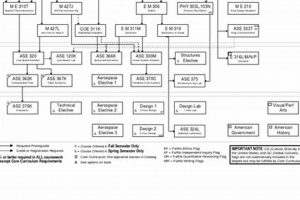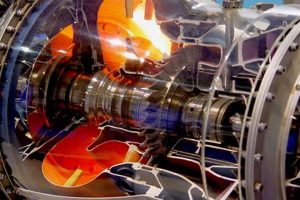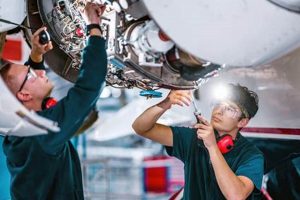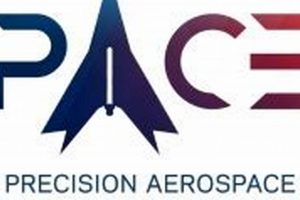Opportunities following the completion of an aerospace engineering degree are diverse and encompass a wide array of specializations within the aeronautics and astronautics fields. These opportunities involve the design, development, testing, and production of aircraft, spacecraft, satellites, and related systems. For example, graduates may find roles in designing fuel-efficient aircraft, developing advanced satellite communication systems, or contributing to the exploration of space through the design of spacecraft components.
These pursuits are vital for advancing technological capabilities, facilitating global communication, and expanding scientific knowledge. The fields importance lies in its contributions to national security, economic competitiveness, and scientific discovery. Historically, advancements in aerospace engineering have led to significant improvements in air travel safety, efficiency, and accessibility, as well as breakthroughs in space exploration that have expanded our understanding of the universe.
The following sections will delve into specific roles, sectors, and pathways that individuals with an aerospace engineering background can pursue. These areas include design engineering, research and development, testing and analysis, manufacturing, project management, and various governmental and academic positions.
The landscape for individuals with aerospace engineering expertise is extensive. Strategically planning one’s academic and professional journey can significantly enhance prospects within this competitive field.
Tip 1: Cultivate a Strong Foundation in Core Principles. A comprehensive understanding of fundamental engineering principles, including aerodynamics, thermodynamics, structural mechanics, and control systems, is essential. Focus on mastering these core concepts through rigorous coursework and practical application.
Tip 2: Specialize Through Advanced Studies. Consider pursuing advanced degrees, such as a Master’s or Doctorate, to develop specialized knowledge in a specific area of interest, such as propulsion systems, composite materials, or autonomous flight control. Specialization increases marketability in niche areas of the industry.
Tip 3: Gain Practical Experience Through Internships. Seek out internship opportunities with established aerospace companies, government agencies (e.g., NASA, FAA), or research institutions. Internships provide invaluable hands-on experience, networking opportunities, and a realistic understanding of the day-to-day tasks involved in various roles.
Tip 4: Develop Proficiency in Relevant Software and Tools. Familiarize oneself with industry-standard software packages for design, simulation, and analysis, such as CAD/CAM software, computational fluid dynamics (CFD) tools, and finite element analysis (FEA) programs. Proficiency in these tools is often a prerequisite for many entry-level positions.
Tip 5: Build a Professional Network. Actively participate in industry conferences, join professional organizations (e.g., AIAA), and connect with engineers and researchers in the field. Networking can provide valuable insights into industry trends, potential career paths, and job opportunities.
Tip 6: Focus on Developing Strong Communication Skills. Aerospace engineers frequently collaborate in multidisciplinary teams and must be able to effectively communicate technical information to both technical and non-technical audiences. Practice written and oral communication skills through presentations, reports, and technical writing courses.
Tip 7: Stay Abreast of Emerging Technologies. The aerospace industry is constantly evolving. Remain informed about emerging technologies, such as additive manufacturing, electric propulsion, and advanced materials, through continuous learning and professional development. This proactive approach demonstrates a commitment to staying at the forefront of the field.
Proactive planning and continuous skill development are crucial for maximizing success. By focusing on core principles, specialization, practical experience, and professional development, individuals can position themselves for fulfilling contributions to the aerospace industry.
The subsequent discussion will provide a concluding overview of the opportunities and the potential for impact within aerospace engineering.
1. Design Engineer
The role of a Design Engineer represents a foundational element within aerospace engineering career options. This position involves the application of engineering principles to create and improve aircraft, spacecraft, and related systems. The responsibilities are multifaceted, requiring a blend of technical expertise, problem-solving skills, and creativity.
- Conceptual Design and Analysis
Design Engineers are tasked with generating initial designs for aerospace components and systems, often using computer-aided design (CAD) software. These designs must then undergo rigorous analysis to ensure they meet performance requirements, structural integrity standards, and regulatory guidelines. For instance, a Design Engineer might develop a new wing design for an aircraft, simulating its aerodynamic performance using computational fluid dynamics (CFD) software to optimize lift and minimize drag. This process has direct implications for aircraft fuel efficiency and overall performance.
- Material Selection and Component Integration
The selection of appropriate materials for aerospace applications is a critical aspect of design engineering. Design Engineers must consider factors such as strength-to-weight ratio, corrosion resistance, and cost when choosing materials for different components. Furthermore, they are responsible for integrating various components into a cohesive system, ensuring that they function harmoniously. An example would be the selection of advanced composite materials for the fuselage of a new aircraft, balancing the need for lightweight construction with the requirements for structural strength and durability. This directly impacts the safety and longevity of the aircraft.
- Prototyping and Testing
After the initial design phase, Design Engineers often oversee the creation of prototypes to validate their designs. This involves working closely with manufacturing teams to fabricate components and assemble systems. Prototypes are then subjected to rigorous testing to identify any design flaws or areas for improvement. For example, a Design Engineer might oversee the testing of a new engine nozzle design in a wind tunnel to measure its thrust and efficiency characteristics. The results of these tests inform further design refinements and ensure that the final product meets performance expectations.
- Documentation and Collaboration
Thorough documentation is essential in aerospace engineering to ensure traceability and maintainability of designs. Design Engineers are responsible for creating detailed drawings, specifications, and reports that describe the design, materials, and performance characteristics of aerospace systems. They also collaborate with other engineers, scientists, and technicians to ensure that designs are properly implemented and integrated. For instance, a Design Engineer working on a satellite project might collaborate with electrical engineers to ensure that the satellite’s power and communication systems are compatible with the structural design. Effective documentation and collaboration are crucial for ensuring the success of complex aerospace projects.
In conclusion, the Design Engineer role, central to aerospace engineering career options, encompasses a diverse range of responsibilities that contribute directly to the advancement of aviation and space exploration. The facets discussed highlight the importance of technical expertise, problem-solving skills, and collaboration in this critical role.
2. Research Scientist
The role of a Research Scientist within the framework of aerospace engineering career options represents a critical avenue for advancing the field. The work involves theoretical investigation, experimentation, and the development of new technologies that can significantly influence future aerospace systems. A Research Scientist’s contributions act as a catalyst, driving innovation in areas such as propulsion, materials science, aerodynamics, and autonomous systems. Without this dedication to discovery, the potential for advancement would be greatly diminished. For instance, a Research Scientist might focus on developing more efficient jet engine designs, experimenting with new combustion techniques to reduce fuel consumption and emissions. This research directly impacts the sustainability and environmental impact of air travel.
Further amplifying the importance, consider the development of advanced composite materials. Research Scientists explore new polymer matrices and reinforcement fibers, leading to lighter and stronger materials for aircraft construction. This has a cascading effect, as lighter aircraft require less fuel, can carry larger payloads, and exhibit improved maneuverability. Similarly, work on autonomous systems, guided by Research Scientists, has enabled the development of unmanned aerial vehicles (UAVs) for various applications, from surveillance and reconnaissance to package delivery and search and rescue operations. These efforts require a deep understanding of control theory, sensor technology, and artificial intelligence. In each case, the ability to transform abstract concepts into tangible technologies is a direct result of contributions by Research Scientists.
In summary, the link between Research Scientists and aerospace engineering career options is undeniable. Research Scientist roles are essential for ensuring that aerospace engineering remains at the forefront of technological innovation. The challenges addressed by these professionals, ranging from fuel efficiency and safety to exploring new frontiers in space exploration, will shape the future of air and space travel. The capacity for fundamental inquiry and applied development defines this key facet of aerospace engineering, underscoring the immense impact of Research Scientists within the industry.
3. Project Manager
The intersection of project management and aerospace engineering career options signifies a critical nexus for successful execution within the industry. Aerospace projects are inherently complex, demanding precise coordination, rigorous risk management, and strict adherence to budget and schedule constraints. The Project Manager serves as the central orchestrator, responsible for guiding projects from conception to completion. Without effective project management, even the most innovative designs and technological advancements can be derailed, leading to cost overruns, delays, and potentially, compromised safety. For example, the development of a new satellite constellation requires meticulous planning to coordinate the design, manufacturing, testing, launch, and operational phases. A Project Manager oversees these interconnected activities, ensuring that each team delivers its outputs on time and within budget, and that any issues are promptly addressed to minimize disruption.
The skillset of an aerospace project manager extends beyond technical expertise. Proficiency in leadership, communication, and negotiation are essential for managing diverse teams of engineers, scientists, technicians, and contractors. A successful project manager must also possess a deep understanding of regulatory requirements and industry standards to ensure compliance and minimize potential liabilities. Consider the development of a new commercial aircraft. The project manager must navigate complex regulatory frameworks set by aviation authorities, manage interactions with numerous suppliers and subcontractors, and ensure that the aircraft meets stringent safety and performance criteria. Effective risk assessment and mitigation strategies are also critical, as unforeseen technical challenges or supply chain disruptions can significantly impact project timelines and costs. In addition, project managers need expertise to communicate technical information to stakeholders with varying degrees of technical proficiency. Strong leadership skills are required to keep team members motivated and working cohesively to achieve common goals.
In summary, the role of a Project Manager is integral to aerospace engineering career options. Effective project management is a key determinant of success in an industry characterized by complexity, high stakes, and demanding timelines. The skills and expertise of project managers are crucial for translating innovative ideas into tangible realities, ensuring that aerospace projects are delivered safely, efficiently, and effectively. The ability to manage resources, mitigate risks, and communicate effectively is paramount for achieving project objectives and contributing to the advancement of the aerospace industry.
4. Test Engineer
Within aerospace engineering career options, the role of a Test Engineer is pivotal for ensuring the safety, reliability, and performance of aerospace systems. This engineering discipline focuses on rigorously evaluating components, systems, and entire vehicles through a range of testing methodologies. The insights gained from these tests are critical for identifying design flaws, validating performance predictions, and ultimately, certifying aerospace products for operational use.
- Test Planning and Design
Test Engineers are responsible for developing comprehensive test plans that outline the objectives, procedures, and acceptance criteria for each test. This involves selecting appropriate testing methods, designing test fixtures, and specifying instrumentation requirements. For instance, when testing a new aircraft wing, a Test Engineer might design a test fixture that simulates the aerodynamic loads experienced during flight. This ensures that the wing can withstand the stresses it will encounter in real-world conditions. This contributes directly to the aircraft’s overall safety and performance.
- Test Execution and Data Acquisition
During test execution, Test Engineers oversee the operation of test equipment, collect data, and monitor system performance. This requires a thorough understanding of instrumentation, data acquisition systems, and real-time data analysis techniques. For example, in a rocket engine test, Test Engineers monitor parameters such as thrust, pressure, temperature, and flow rate to assess the engine’s performance and identify any anomalies. Accurate data acquisition and analysis are essential for making informed decisions about the engine’s design and operational characteristics.
- Failure Analysis and Troubleshooting
A critical aspect of a Test Engineer’s job involves analyzing test data to identify the root cause of failures or performance deviations. This requires a strong understanding of engineering principles, failure modes, and troubleshooting techniques. For instance, if a component fails during a vibration test, the Test Engineer might use techniques such as microscopy and non-destructive testing to examine the failed part and determine the underlying cause of the failure. This information is then used to improve the component’s design or manufacturing process, making it more reliable.
- Reporting and Documentation
Test Engineers are responsible for documenting all aspects of the testing process, including test plans, procedures, data, and results. This documentation is used to communicate findings to other engineers, regulatory agencies, and customers. Clear and accurate reporting is essential for ensuring that test results are properly interpreted and that any necessary corrective actions are taken. For example, a Test Engineer might prepare a comprehensive test report for a new aircraft system, summarizing the test results and providing recommendations for improvements. The quality of test documentation directly impacts regulatory approvals and public safety.
In summary, the Test Engineer role provides a vital contribution to aerospace engineering career options. Their expertise in test planning, execution, analysis, and reporting ensures that aerospace systems meet stringent performance and safety requirements. These individuals contribute directly to the integrity and success of aerospace endeavors.
5. Manufacturing Specialist
The correlation between a Manufacturing Specialist and aerospace engineering career options is substantive, stemming from the highly specialized and precise manufacturing processes inherent to the aerospace sector. The complex designs generated by aerospace engineers necessitate equally sophisticated manufacturing techniques to bring them to fruition. Manufacturing Specialists are therefore indispensable in bridging the gap between theoretical designs and physical realities. The causes driving the demand for these specialists include the stringent material requirements, dimensional tolerances, and quality control standards imposed by the industry. A direct effect of their expertise is the assurance of structural integrity, performance efficiency, and ultimately, the safety of aerospace vehicles. For example, the manufacturing of turbine blades for jet engines requires specialists skilled in processes such as precision casting, machining, and surface treatment to ensure the blades can withstand extreme temperatures and stresses. This directly impacts engine performance and reliability.
Furthermore, the role extends beyond simply executing manufacturing processes. Specialists are involved in optimizing production workflows, implementing advanced manufacturing technologies such as additive manufacturing (3D printing) for rapid prototyping and production of complex parts, and ensuring compliance with rigorous industry regulations. The practical applications of their knowledge are extensive. They may contribute to the development of new composite materials manufacturing techniques, implement robotic automation for precision assembly of aircraft components, or devise innovative quality control methods using non-destructive testing. These contributions directly impact the cost-effectiveness, efficiency, and scalability of aerospace manufacturing. They frequently collaborate with design engineers to provide feedback on manufacturability, influencing design decisions to streamline production processes and reduce manufacturing costs.
In summary, the presence of Manufacturing Specialists is a critical component within the broader spectrum of aerospace engineering career options. Their expertise in translating complex designs into tangible products is essential for advancing the industry. The challenges involved require a continuous focus on innovation, process optimization, and quality control. Understanding the practical significance of this role underscores the need for skilled manufacturing professionals in sustaining the growth and technological advancement of the aerospace sector.
6. Academia/Government
Academia and government sectors represent vital pathways within aerospace engineering career options. These roles are integral to both the advancement of fundamental knowledge and the implementation of national aerospace strategies.
- Research and Development
Academic institutions and government laboratories serve as primary centers for aerospace research and development. Engineers and scientists in these settings engage in projects ranging from basic scientific inquiry to the development of cutting-edge technologies. For instance, researchers at universities might investigate novel propulsion concepts or develop advanced materials for spacecraft. These efforts not only expand the body of knowledge in aerospace engineering but also train the next generation of engineers and scientists. Government laboratories, such as those operated by NASA, often focus on more applied research, developing technologies and systems for specific missions or applications. The outputs from these research endeavors have significant implications for innovation and national competitiveness in the aerospace sector.
- Education and Training
Universities and colleges play a crucial role in educating and training future aerospace engineers. Faculty members design curricula, teach courses, and mentor students, preparing them for careers in industry, government, and academia. These educational programs must adapt to the evolving needs of the aerospace industry, incorporating new technologies and addressing emerging challenges. Furthermore, universities often collaborate with industry partners to provide students with hands-on experience and real-world learning opportunities. The quality of aerospace engineering education directly impacts the future workforce and the pace of innovation in the field.
- Regulatory Oversight and Policy Development
Government agencies, such as the Federal Aviation Administration (FAA) and the Department of Defense (DoD), play a vital role in regulating the aerospace industry and developing national aerospace policy. Engineers and policymakers in these agencies establish safety standards, oversee air traffic control, and manage government aerospace programs. Their decisions have a profound impact on the safety, efficiency, and sustainability of air travel and space exploration. Furthermore, government agencies often fund research and development projects that support national aerospace priorities. The decisions made by regulatory and policy bodies shape the direction of the aerospace industry and influence the career paths available to aerospace engineers.
- Consulting and Advisory Roles
Aerospace engineers often serve as consultants or advisors to government agencies and academic institutions, providing their expertise on a wide range of technical and policy issues. These roles can involve participating in expert panels, conducting technical reviews, or developing recommendations for government programs. For example, an aerospace engineer might serve on an advisory committee for NASA, providing input on the agency’s strategic plan or reviewing the technical feasibility of a proposed mission. Consulting and advisory roles provide engineers with an opportunity to contribute their knowledge and experience to inform decision-making at the highest levels of government and academia.
The facets described underscore the extensive influence of academia and government in shaping the landscape of aerospace engineering career options. These sectors offer opportunities to contribute to groundbreaking research, educate future engineers, influence policy, and provide expert guidance, thereby fostering progress and innovation in the field.
Frequently Asked Questions
The following addresses common inquiries regarding aerospace engineering career options, providing detailed and factual responses to promote a deeper understanding of the field.
Question 1: What is the primary distinction between aeronautical and astronautical engineering?
Aeronautical engineering focuses on the design, development, and testing of aircraft that operate within Earth’s atmosphere. Astronautical engineering, conversely, deals with the design and construction of spacecraft and related systems that operate in outer space. While both fields share foundational engineering principles, they diverge in their specific areas of specialization.
Question 2: What are the essential skills for success in aerospace engineering careers?
Success in aerospace engineering necessitates a strong foundation in mathematics, physics, and computer science. Critical thinking, problem-solving, and analytical skills are also paramount. Furthermore, effective communication, teamwork, and project management capabilities are indispensable for collaborative projects within the industry.
Question 3: What are the typical entry-level positions for aerospace engineering graduates?
Entry-level positions commonly include roles such as design engineer, test engineer, research assistant, and manufacturing engineer. These positions provide opportunities to apply academic knowledge to practical problems and gain experience in various aspects of aerospace engineering.
Question 4: How does advanced education impact career prospects in aerospace engineering?
Advanced degrees, such as a Master’s or Doctorate, often enhance career prospects and lead to specialized roles in research, development, or management. Advanced education can also open doors to leadership positions and opportunities to contribute to cutting-edge aerospace technologies.
Question 5: What are the key industry sectors employing aerospace engineers?
Key industry sectors include aircraft manufacturing, spacecraft manufacturing, defense, government agencies (e.g., NASA, FAA), research institutions, and consulting firms. Each sector offers unique challenges and opportunities for aerospace engineers.
Question 6: What role does software proficiency play in aerospace engineering careers?
Proficiency in industry-standard software tools, such as CAD/CAM software, computational fluid dynamics (CFD) programs, and finite element analysis (FEA) packages, is crucial for aerospace engineers. These tools are used for design, simulation, and analysis, and proficiency in these tools is often a requirement for many positions.
The information provided highlights the diversity and demands inherent in aerospace engineering career options. A strategic approach to education and skill development is essential for success.
The following sections will provide a concluding overview of the opportunities and the potential for impact within aerospace engineering.
Aerospace Engineering Career Options
This exploration has detailed the breadth of “aerospace engineering career options,” highlighting roles such as Design Engineer, Research Scientist, Project Manager, Test Engineer, and Manufacturing Specialist, as well as opportunities in Academia and Government. Each path requires specific skill sets and contributes uniquely to the advancement of the field. The FAQ section addressed common concerns and provided clarity regarding essential skills, educational requirements, and industry sectors.
The continued advancement of aerospace technology necessitates a commitment to excellence and innovation. Aspiring engineers are encouraged to pursue rigorous academic preparation and seek practical experience to contribute meaningfully to this dynamic and critical field. The future of air and space travel, national security, and scientific discovery depends on the expertise and dedication of those who choose to pursue “aerospace engineering career options.”







